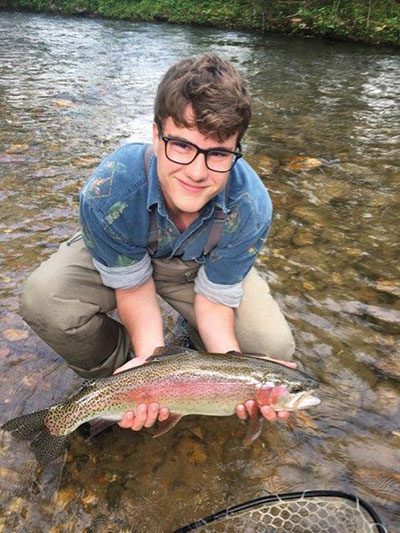August is a great time to throw the biggest dry flies you have. I’m talking about the biggest and nastiest ones! About anywhere you go around here in the southern Appalachia’s, big dries will work, from the smallest streams to even tailwaters. Look to be casting hoppers, beetles, Letort Crickets and any of the biggest terrestrials.
Many of our sparse hatches of mayflies and caddis flies have dissipated. If you see a hatch, these insects will be small. Since trout have become accustomed to looking up for their next meal, these larger flies can make it very enticing for trout to engulf them. We have been catching some monster trout lately feasting on what we’ve been offering them! Remember that fishing on a breezy early morning or late evening day will produce these larger terrestrials in our streams. Many will be knocked off due to being careless, the wind, or by being on the wrong leaf that becomes detached. One of the best things about throwing larger flies is that most anglers, at any age, can see them.
Here are some tips on how to use that big dry fly. I see many anglers attempting to softly land a large dry fly pattern. Don’t spend too much time worrying about a soft cast. Big bugs don’t land softly. They smack the water. And big trout eat big patterns! We catch many large trout that come up from nowhere to eat these types of flies.
First, you must get their attention. A real bug/hopper is heavy, and it’s got some meat to it. They hit the water’s surface with what I would call a “blop”, and this is the attention getter! If no luck on that big dry, then go with a hopper/dropper pattern with a big number 6 or 8 on top, with a small number 16–20 as the dropper. Remember, hatches are smaller in the summertime.
Good casters can toss these rigs up under the rhododendron canopy where a likely trout will be hiding, and they can put flies where many anglers cannot. One of my favorite sayings (and there’s a lot of truth behind this) is “Good Casters catch all the Fish”. Anyways, grassy areas along the bank are a surefire place where grasshoppers may find their way into the stream. Casting a beetle pattern above a bank laden log can be another dandy place to float that dry by, and yes, even out in the wide-open middle of the stream. Use caution when casting these big hopper patterns as you may get the shock of a lifetime!
Don’t forget about asking us about our float trips. We are currently doing floats on the Toccoa Tailwater. She has been fishing pretty well lately. Casting problems – let us teach you the “Art of Fly Fishing” with one of our schooled instructors! Wanting to catch that trout of a lifetime – Give Us a Call, We’ll Hook You Up!
Reel ‘Em In Guide Service is an Orvis Endorsed Fly Fishing Guide based out of beautiful Ellijay, Georgia. They have been offering their services to fly anglers since 2001. Their Special Use Permit for Guiding allows them on the Chattahoochee National Forest, they have licensed guides for North Carolina, offer over 7 miles of private trophy waters across Georgia, and offer drift boat trips on the Toccoa River and the Tuckasegee River in NC.
